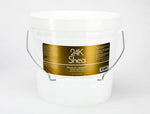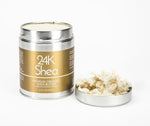Have you ever noticed that some raw African shea butter can be really thick and hard, while another batch will be much more pliable and easy to spread? Have you ever wondered why? The answer lies in the essential fatty acid content found in shea butter. All oils contain EFA’s, and it’s these little fatty acid guys that are responsible for some of their moisturizing properties, as well as the overall texture of the oil.
Shea butter is made up of five primary essential fatty acids, palmitic acid, stearic acid, linoleic acid, oleic acid, and arachidic acid, the most common of which are oleic acid and stearic acid. Each fatty acid lends a different therapeutic quality to the shea butter, but it is mainly the stearic and oleic acids that have the most influence over the shea butter’s texture; the stearic acid is responsible for how solid the shea butter is, and the oleic acid influences how hard or soft the shea butter is.
Interestingly, different shea trees growing in various regions of Africa produce shea butter with different percentages of oleic and stearic acids. For example, shea butter that comes from Uganda typically has a rather high percentage of oleic acid, and as a result Ugandan shea butter is a liquid in warm temperatures. Whereas shea butter that is grown and produced in the West African regions is more variable, with the oleic acid content making up a more broad range of percentages.
The West African region of Burkina Faso typically produces shea butter with a higher stearic acid content than the rest of West Africa, and so the shea butter coming out of there is typically harder than the rest of the shea coming out of West Africa. And what’s even more interesting is that two African shea trees can grow right next to each other, and one tree will produce a more hard shea butter while the other will produce a shea butter that is more soft.
It is this variability in essential fatty acid content that accounts for the differences in texture found in raw shea butter. These EFA’s are also responsible for some of the healing and moisturizing properties of shea butter. Whether your shea comes from Uganda and is thinner, or is thicker and from Burkina Faso, rest assured that you are still getting all the wonderful benefits African shea butter is known for.



